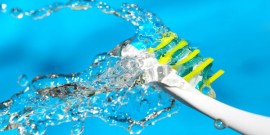
Have you ever wondered what might be making it’s way onto your toothbrush in the bathroom? Read on to find out how you can keep your toothbrush as clean as possible. Thanks for visiting us at Shoreline Endodontics of Groton, CT.
Do you know Staphylococci, coliforms, pseudomonads, yeasts, intestinal bacteria and — yes — even fecal germs may be on your toothbrush?
Appropriate toothbrush storage and care are important to achieving personal oral hygiene and optimally effective plaque removal, says Maria L. Geisinger, DDS, assistant professor of periodontology in the School of Dentistry at the University of Alabama at Birmingham.
“The oral cavity is home to hundreds of different types of microorganisms, which can be transferred to a toothbrush during use,” Geisinger said. “Furthermore, most toothbrushes are stored in bathrooms, which exposes them to gastrointestinal microorganisms that may be transferred via a fecal-oral route. The number of microorganisms can vary wildly from undetectable to 1 million colony-forming units (CFUs). Proper handling and care of your toothbrush is important to your overall health.”
What constitutes proper care and handling? Geisinger answers several questions that may help better protect families from toothbrush germs.
Q. Can bacteria from your toilet really reach your toothbrush?
A. “The short answer is ‘yes.’ Enteric bacteria, which mostly occur in the intestines, can transfer to toothbrushes and thus into your mouth. This may occur through inadequate hand-washing or due to microscopic droplets released from the toilet during flushing. The topic of dirty toothbrushes was a recent subject of the popular Discovery Channel show “Mythbusters,” when 24 toothbrushes were tested, and all of them demonstrated enteric microorganisms — even those that had not been inside of a bathroom. In fact, toothbrushes may be contaminated with bacteria right out of the box, as they are not required to be packaged in a sterile manner.”
Q. What is the proper way to clean your toothbrush to help remove germs?
A. “You should thoroughly rinse toothbrushes with potable tap water after brushing to remove any remaining toothpaste and debris. Additionally, soaking toothbrushes in an antibacterial mouth rinse has been shown to decrease the level of bacteria that grow on toothbrushes.”
Continue reading HERE.






